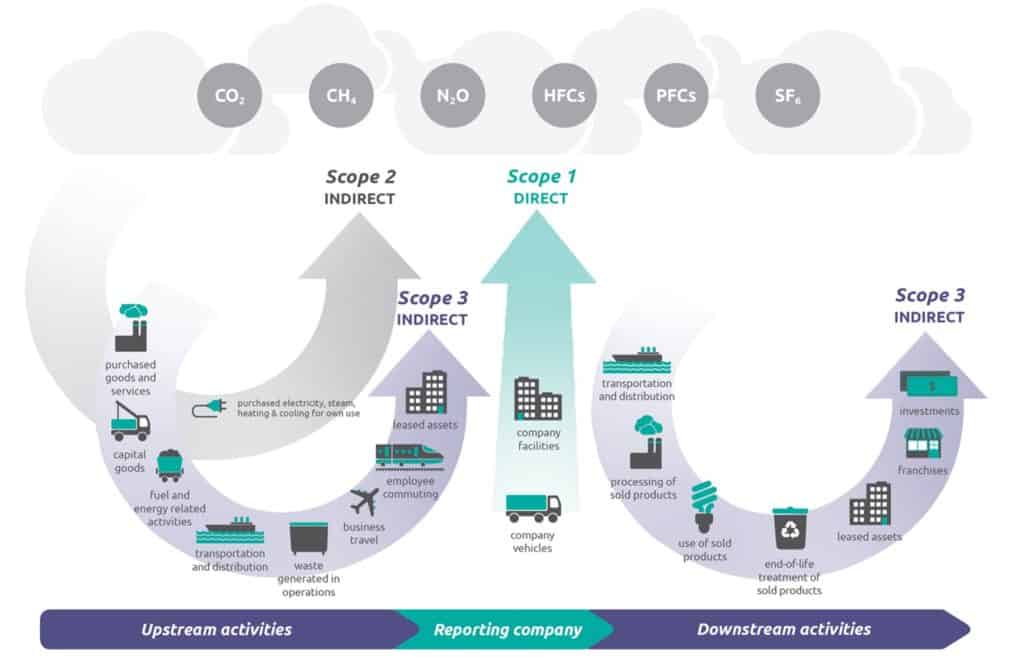Why do emissions matter?
Greenhouse gas (GHG) emissions are a major contributor to global climate change. According to a report by the UN’s Intergovernmental Panel of Climate Change (IPCC), GHG emissions from human activities are the most significant driver of observed climate change since the mid-20th century. Climate change experts have warned nations and industries repeatedly that inaction concerning the reduction of GHG emissions will lead to alarming levels of worldwide hunger, mass migration challenges, the collapse of financial markets, and other collateral damage to society and the economy.
By the end of 2021, several countries, including China, India, and Saudi Arabia, released their Net Zero goals. Businesses are reexamining their priorities based upon the negative impact to environments that is an increasingly investigated, regular byproduct of industry. Large companies (Apple, for instance) have made commitments to transform their supply chains, in an effort to reach carbon-neutrality. Nine other large companies founded the Transform to Net Zero initiative intending to accelerate the transition to a Net Zero carbon economy across the globe, to be reached before 2050. Additionally, global frameworks such as the GRI, SASB, CDP, UN Global Compact, and the Task Force on Climate-related Financial Disclosures (TFCD) have established standards for businesses to report their efforts in reducing their emissions and carbon footprint. With all these combined efforts, the fight to slow climate change is gaining traction.
As businesses plan initiatives to reduce their emissions, they can measure their GHG emissions. After protocols have been implemented to manage GHG emissions, these initial measurements will help companies continue to assess their goals and reach their GHG emissions reduction target. Using the GHG Protocol’s Scopes 1, 2, and 3 helps those businesses seeking to make a change visualize their carbon footprints, identify their specific emissions, and report their progress in reducing them.
The Role of the GHG Protocol
In response to a CDP survey in 2016, 92% of Fortune 500 companies reported that they used GHG Protocol to account for their GHG emissions. Through a partnership between the World Resources Institute (WRI) and the World Business Council for Sustainable Development (WBCSD), the GHG Protocol was created. It lends a standard for structuring the measurement and management of GHG emissions for every part of organizational operations, including value chains and mitigation actions.
What is “Scope?”
The GHG Protocol has established a classification of GHG emissions called “Scope.” There is Scope 1, Scope 2, and Scope 3. The “Scope” of GHG emissions is defined as a classification of the operational boundaries where greenhouse gas (GHG) emissions occur.

Image Source: Corporate Value Chain (Scope 3) Accounting and Reporting Standard, page 5.
These emissions enter the atmosphere as a direct result of company-owned and controlled resources. This entails activities performed at the ground level of the company. Stationary combustion, mobile emissions, process emissions, and fugitive emissions are all classified as Scope 1 if the company owns or controls the activities or equipment associated with the emissions.
Stationary combustion: emissions from the combustion of fossil fuels for heating and industrial applications that take place on-site.
Mobile combustion: emissions from vehicles or other forms of transportation (owned or under the control of a company) that operate by the combustion of fossil fuels.
Fugitive emissions: accidental emissions of vapors or gasses from pressurized apparatuses. These can be due to faulty equipment, leakage, or other unforeseen mishaps that take place at the company site. Though not limited to industrial settings, most fugitive emissions occur in factories and power plants. Because many power generation stations have an incredibly high potential for fugitive emissions, they can comprise an alarming amount of the total emissions on site.
Process emissions: emissions created in industrial and manufacturing processes at the company’s site.
Scope 2 emissions are indirect emissions from an organization’s energy usage. These types of emissions are created by means of purchased electricity, steam, heating, and cooling, from a utility provider, but consumed by the company.
Scope 3: Other Indirect Emissions
Scope 3 includes all emissions that cannot be classified under Scope 1 or Scope 2, but that the organization is still responsible for indirectly across its value chain. This entails emissions related to purchased goods and services, business travel, employee commuting, waste disposal, use of sold products, transportation and distribution (from both customers and suppliers), investments, and leased assets and franchises.
Scope 3 is generally the most negatively impactful to the climate. According to a Deloitte insight, Scope 3 emissions make up more than 70 percent of the carbon footprint from many businesses. Businesses looking to adopt best practices in meeting their Net Zero goals will need to commit to emissions reduction plans, with special emphasis on Scope 3.
Author Bio

Fatima Fasih
Experienced in corporate sustainability in both developed and emerging markets, Fatima Fasih has over 5 years of experience in advising businesses on their sustainability strategies and reporting. She also assists businesses in identifying their progress on the UN Sustainable Development Goals.
Currently, working as an independent Sustainability Consultant, Fatima holds a Masters degree in Sustainability Management and Bachelors in Health Sciences and Environmental Science from the University of Toronto.
She is also certified a Greenhouse Gas Inventory Quantifier (GHG-IQ) and aims to work towards pushing businesses to play a larger role in solving the world’s biggest sustainable development problems: hunger, poverty, and inequality.



